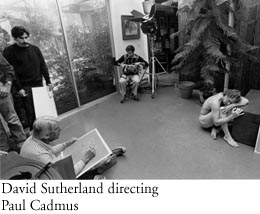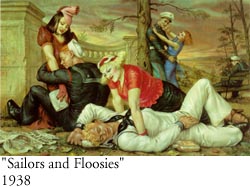 |  |  | 

 Looking up, the artist abruptly lifts his pencil from the paper. "The wrist's in the wrong position,"
he says, lifting himself from his seat on the floor. He approaches the nude model and makes an
imperceptible change in the alignment of the man's fingers. Satisfied, he returns to his seat.
"Generally, men are much better models," he says as he resumes sketching. "They work harder on
their posing, perhaps because they're so much vainer than women." His voice hesitates but his
pencil keeps moving. "Or maybe women think they're so lovely they don't have to pose well. I
don't know."
Looking up, the artist abruptly lifts his pencil from the paper. "The wrist's in the wrong position,"
he says, lifting himself from his seat on the floor. He approaches the nude model and makes an
imperceptible change in the alignment of the man's fingers. Satisfied, he returns to his seat.
"Generally, men are much better models," he says as he resumes sketching. "They work harder on
their posing, perhaps because they're so much vainer than women." His voice hesitates but his
pencil keeps moving. "Or maybe women think they're so lovely they don't have to pose well. I
don't know."
The artist, Paul Cadmus, is the focus of this intimate film portrait, "Paul Cadmus: Enfant Terrible at 80,"
directed by David Sutherland.
 In 1934, while on the government's WPA, Cadmus painted a satiric view of rowdy sailors on
shore leave in a New York park. The painting was chosen for a special exhibit of works by New
Deal painters, and it was hung at Washington's Corcoran Gallery. Before the opening, a VIP
group viewed the exhibit. The group included a strait-laced admiral who was outraged at what he
considered an insult to America's sailors, and ordered the painting removed. The
affair became something of a national issue, the center of an often amusing debate about
government censorship and the morals of American military men. The confiscated painting, "The
Fleet's In" was lost, and only recently re-discovered. Sutherland's film records Cadmus' reaction
at seeing the painting for the first time after more than 45 years, at a retrospective of his work in
Oxford, Ohio.
In 1934, while on the government's WPA, Cadmus painted a satiric view of rowdy sailors on
shore leave in a New York park. The painting was chosen for a special exhibit of works by New
Deal painters, and it was hung at Washington's Corcoran Gallery. Before the opening, a VIP
group viewed the exhibit. The group included a strait-laced admiral who was outraged at what he
considered an insult to America's sailors, and ordered the painting removed. The
affair became something of a national issue, the center of an often amusing debate about
government censorship and the morals of American military men. The confiscated painting, "The
Fleet's In" was lost, and only recently re-discovered. Sutherland's film records Cadmus' reaction
at seeing the painting for the first time after more than 45 years, at a retrospective of his work in
Oxford, Ohio.
Sutherland's goal was to make a different kind of artist's profile. "I wanted to make a film about
an artist and his work, without using narrators and interviewers who would come between the
viewers and the subject. The goal was to get the artist to act as host in a film about himself."
Cadmus talks engagingly about subjects ranging from his life-long commitment to satire and
exaggeration ("People's noses should be rubbed in all sorts of things, pleasant and unpleasant, or
else they skip it.") to the paradoxical contrast between an artist's work and his life ("Be regular and
ordinary in your life, like a bourgeois," he says, quoting Flaubert, "So you can be violent and
original in your art.") He demonstrates his masterful technique of
sketching the nude, and painting in egg tempera. He reveals much about himself and his work, but
he will not, he insists, tell all. "I'm not going to unravel all the mysteries," he warns, "I think
people should discover them for themselves."
"Paul Cadmus: Enfant Terrible at 80" was produced and directed by David Sutherland.
Photographed by Joe Seamans. Edited by Michael Colonna. Presented by Fairfield University
under the guidance of Steven Weber, Dean of Arts and Sciences; and with the research assistance
of Art Historian Phillip Eliasoph. Funding was provided by the Sara Roby Foundation, Forbes
Inc., and Maupintours.

|  |